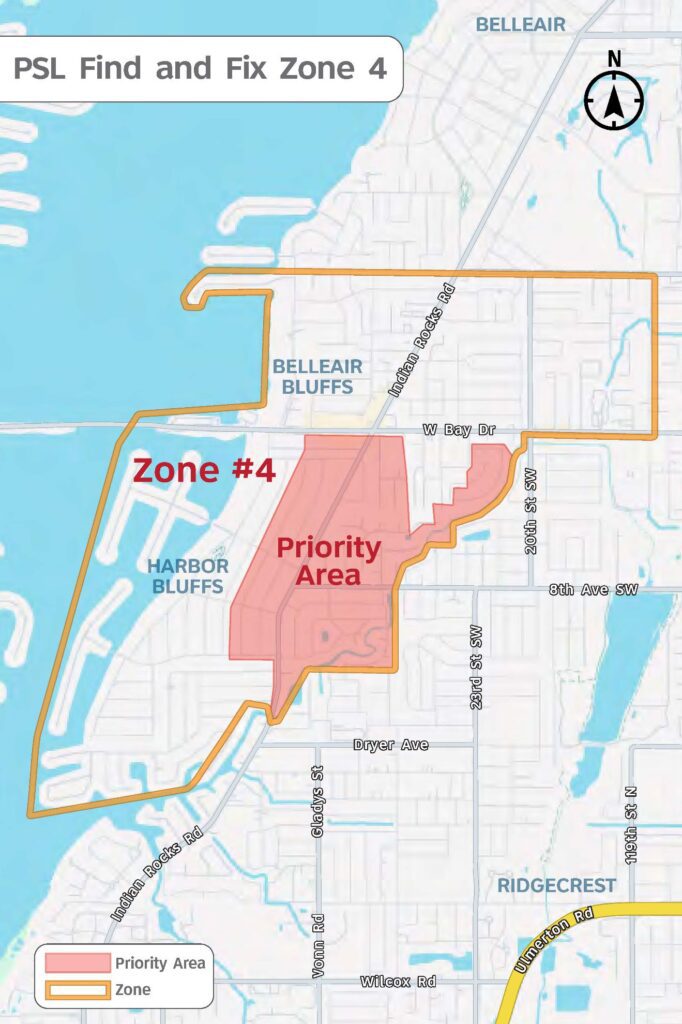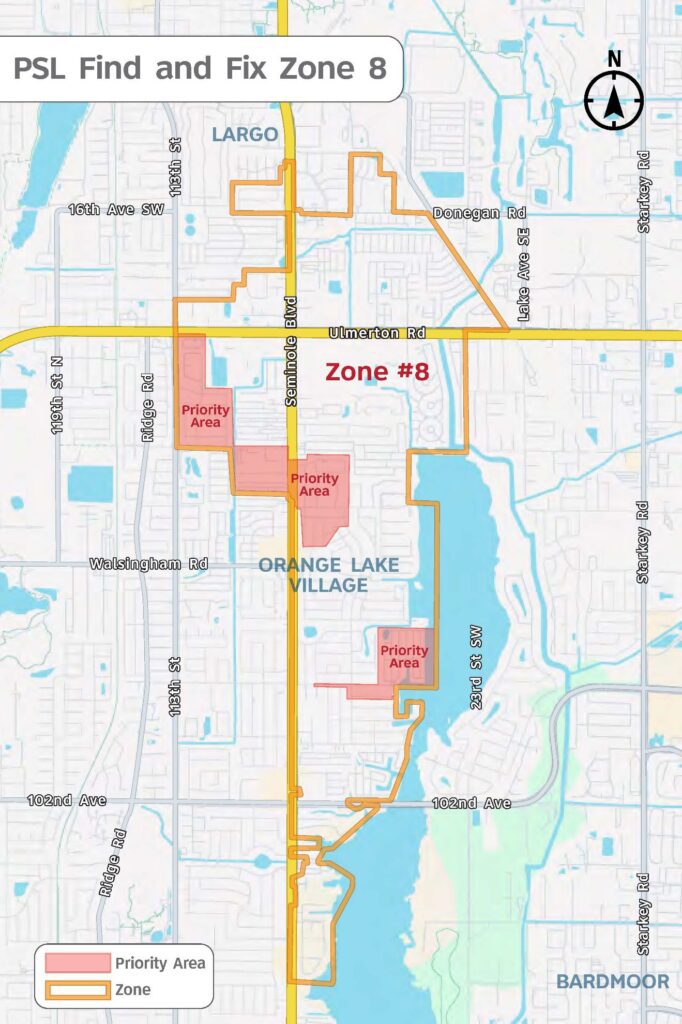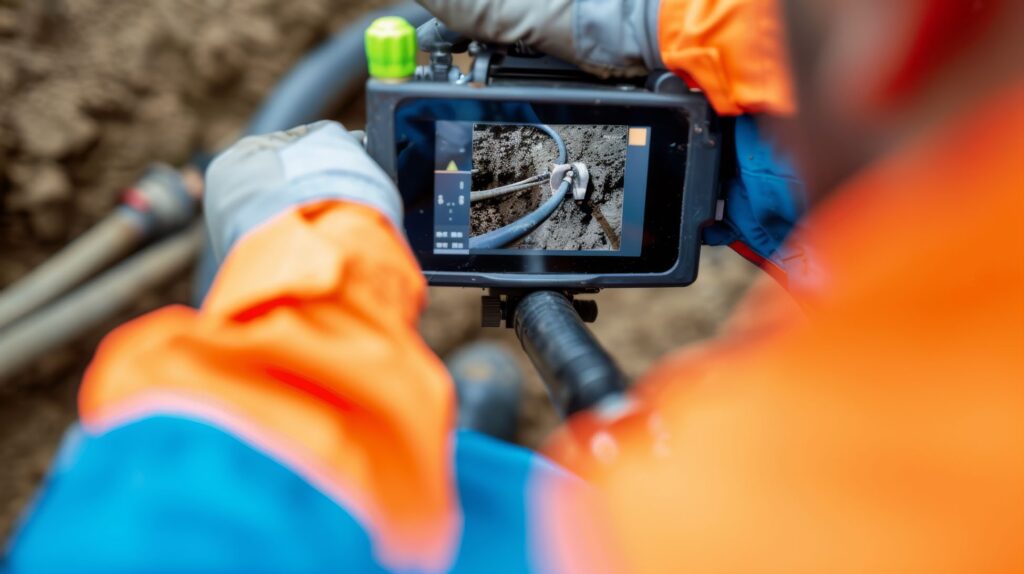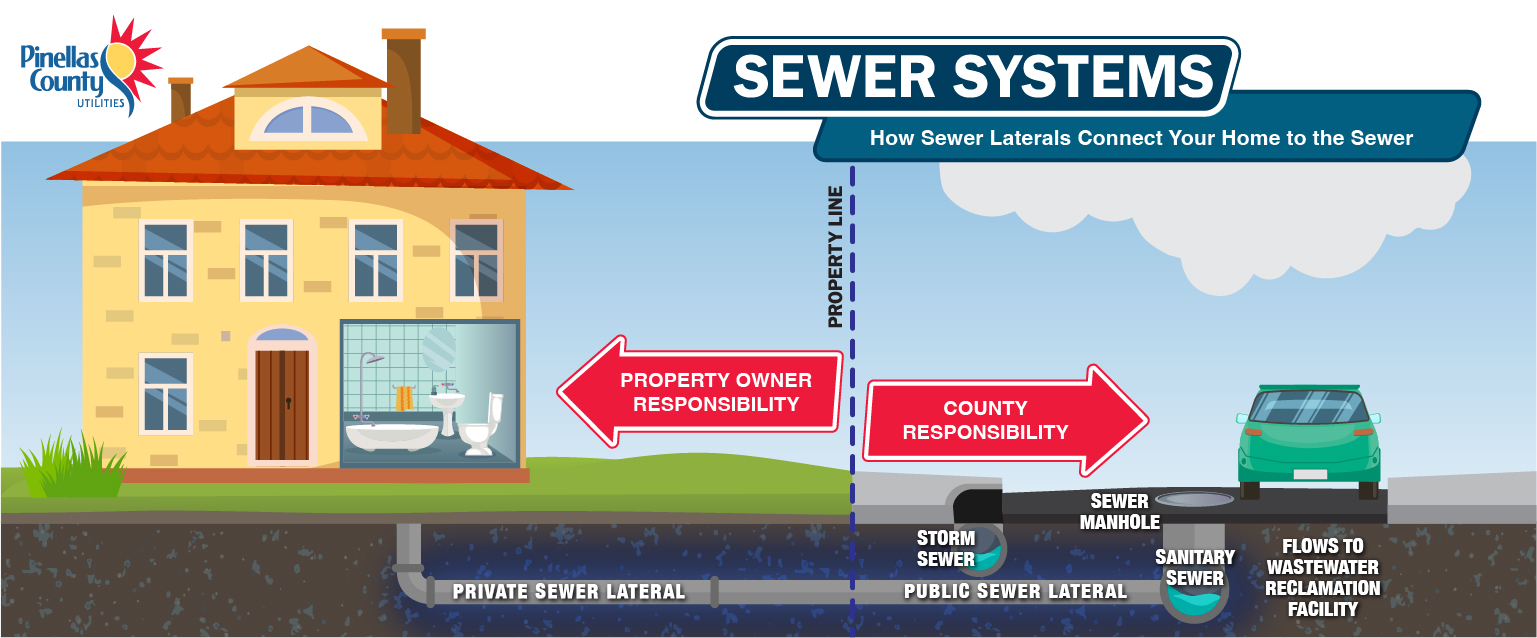Private Sewer Lateral Find and Fix Program
Program Overview
Pinellas County Utilities is launching a Private Sewer Lateral (PSL) Find and Fix Program to identify and repair damaged private sewer laterals and other sewer infrastructure that can contribute to sewage overflows. Areas with significant groundwater or stormwater infiltration—where water enters the sewer system through cracks, joints, or defects in the pipes—have been designated as Priority Zones for inspection and repair. While the County has identified 16 such areas, the current focus is on Zones 4, 8, and 13, which are located in the cities of Largo, Seminole, and St. Petersburg, respectively.
If a property is within one of the identified Priority Zones, the PSL investigation and repairs will be done by the County’s contractor(s) at no cost to the property owner. If a property falls outside of the Priority Zones, it may qualify for one of Pinellas County’s financial assistance programs (Private Sewer Lateral Rebate Program). These programs also aim to reduce inflow and infiltration of groundwater and stormwater into the wastewater collection system, thereby enhancing public health and environmental protection.
Priority Zones
Pinellas County has identified 16 Priority Zones for inspection and repair around the County. Three of these Zones- Zones 4, 8, and 13-are located in the cities of Largo, Seminole, and St. Petersburg, respectively. As this program proceeds, additional zone boundaries may be added.

Priority Zone 4 is located both within the City of Largo and Unincorporated Pinellas County.

Priority Zone 8 is located both within the City of Seminole and Unincorporated Pinellas County.

Priority Zone 13 is located both within the City of St. Petersburg and unincorporated Pinellas County.
Program Phases
Design Phase
This initial phase of work will consist of an evaluation of the sewer system in the Priority Zone areas to determine the condition of the service laterals, manholes, and gravity pipes and identify potential sources of groundwater and stormwater infiltration. The County contractor will use non-destructive inspection methods, including Closed-Circuit Television (CCTV) and smoke testing, to evaluate and document the condition of the pipe. Based on the inspection results, a rehabilitation plan will be developed to restore the proper function of the sewer system and eliminate sources of infiltration. The rehabilitation plan will detail the scope of work, materials needed, and any required permits.
In order to conduct CCTV inspections of service laterals on private properties, and any necessary repairs, the County requires the prior completion of an Access Agreement by the property owner. This agreement grants the County temporary access to the sewer lateral on each property to conduct the necessary pipe inspections and perform any related repair work that may be needed for the proper function of the sewer lateral.

Construction Phase
Based on the inspection findings and rehabilitation plan, the County contractor will undertake the approved repairs and necessary construction. The construction may require the removal of landscaping, concrete, or pavement in the public right of way and/or private property, depending on the location of the failure and infiltration. If necessary, temporary measures like traffic control or barricades may be put in place for safety and to minimize disruption during construction. If only part of the service lateral is damaged (such as a small crack or blockage), it may be repaired using methods like pipe-lining or spot repairs. If the lateral is severely damaged or deteriorated, the entire sewer line may need to be replaced. This involves installing new pipes that connect the property’s plumbing to the public sewer system. The new or repaired lateral will be properly connected to the public sewer system, ensuring that wastewater flows correctly. Any surfaces, such as driveways, sidewalks, or landscaping, that were disturbed during excavation will be repaired or replaced to restore the property’s appearance and usability.
Post-Construction, Measurement and Monitoring Phase
Once construction is completed, flow meters will be placed in the same locations as the pre-construction flow monitoring in order to measure system-wide reductions in stormwater infiltration.
Program Exclusions
While the PSL Find and Fix Program addresses important issues related to maintaining and repairing private sewer laterals, it does not cover certain aspects or situations. These include:
- Cosmetic or Non-Essential Work; i.e., aesthetic improvements and non-emergency plumbing.
- Non-Qualified Repair Work; i.e., DIY repairs and work done by unlicensed professionals.
- Private Property Issues Unrelated to the PSL; i.e., non-sewer lateral plumbing repairs, landscaping, or tree removal.
What is a Private Sewer Lateral?
A Private Sewer Lateral is the section of the sewer line that connects private property, like a home or business, to the public sewer system. It extends from the property or building to the public sewer main, typically located in the street or alley. When a sewer lateral fails, groundwater or stormwater can seep into the pipe through cracks, entering the public sewer system. This extra water causes excessive flow in the sewer lines, potentially overwhelming treatment facilities and leading to sanitary sewer overflows into yards, storm sewers, and waterways. Additionally, cracked sewer laterals can allow untreated wastewater to leak into the surrounding soil, resulting in costly sewage backups in your home. Beyond health and financial concerns, overflows are prohibited by state regulations and could lead to fines for Pinellas County Utilities, as well as increased wastewater treatment fees for customers.

Why is repairing a private sewer lateral important?
The PSL Find and Fix Program’s main purpose is to:
- Identify and Fix Leaks or Failures: The program encourages locating and repairing problems in PSLs, such as leaks, cracks, blockages, or deteriorating pipes. These issues can lead to sewage backups, groundwater contamination, and other health risks.
- Prevent Pollutants from Entering the Stormwater Collection System: If a PSL is leaking or failing, untreated sewage or wastewater could enter storm drains or the surrounding environment. By fixing these issues, the program helps prevent pollution from spreading into water sources.
- Ensure Proper Wastewater Flow: A functioning PSL ensures that wastewater from homes or businesses flows properly into the public sewer collection system, preventing backups and blockages that could result in costly remediation and plumbing repairs.
- Promote Public Health and Safety: Proper maintenance of PSLs reduces the risk of sewer overflows and sewage backups, which can pose serious health risks to both residents and the broader community.
- Reduce Costs and System Strain: When PSLs are maintained properly, it can reduce the load on public sewer systems, preventing premature wear and tear, and avoiding the cost of building expensive collection and treatment capacity improvements to handle excessive flows. These added costs also contribute to higher treatment rates for Pinellas County Utilities’ customers.
The goal of the PSL Find and Fix Program is to investigate the condition of the sewer collection system (including PSLs) within the public right-of-way up to the building to determine if and where there are failures and undertake the necessary repairs to eliminate the sewer system infiltration. If your property is within one of the designated Priority Zones, the investigation and repairs will be done by the County’s contractor(s) at no cost to the property owner.
Contact Us
For more information on the Private Sewer Lateral Find and Fix Program, please contact by telephone at (727) 280-6563 or feel free to email us at Projectinfo@PSLFindandFix.com.
Frequently Asked Questions
What is the Pinellas County Find and Fix Program?
The Find and Fix Program is a proactive approach to maintaining and repairing sewer infrastructure. Under this policy, potential issues or weaknesses in the system are regularly identified (“find”) through inspections, monitoring, and data collection. Once identified, these problems are addressed quickly (“fix”) before they escalate into larger, more expensive, or disruptive issues
Why is this project needed right now?
Many sewer systems, especially in older cities or areas, are aging and may have deteriorated over time, leading to leaks, blockages, or even system failures. This project helps locate and repair these issues before they cause more significant problems.
How is the project being funded?
The project is being funded through Pinellas County’s Capital Improvements Program (CIP).
What is the cost of the project?
Project cost is approximately $4.9M
Where is the project located?
Pinellas County Utilities has identified key areas of excessive Inflow and Infiltration (I&I) within its wastewater system. The program focuses on projects that support the overall rehabilitation of the system, including activities like lining and replacing sewer mains, manholes, and improving both public and private laterals. A total of 16 zones were identified, with three priority areas—Zones 4, 8, and 13—standing out as major contributors to I&I in the southern part of Pinellas County.
If I live in one of the three priority areas, what can I expect during construction?
Depending on the findings, crews will carry out repairs on damaged infrastructure. This could include patching leaks, replacing damaged pipes, clearing blockages, or reinforcing certain sections of the system. In some cases, this may involve digging up areas of the ground to access the sewer lines or other utility systems, although more advanced techniques like trenchless methods may also be used to minimize disruption. Expect to see construction equipment, such as diggers or trucks, in the
work zone. These tools are necessary for digging, transporting materials, and completing repairs.
How will this project benefit the community?
The Find and Fix project will provide several benefits to the community, including:
Increased Property Values: Areas with reliable, well-maintained infrastructure tend to see higher property values. Regular repairs and maintenance help maintain a neighborhood’s appeal for homeowners and potential buyers.
Improved Public Health and Safety: By proactively identifying and addressing sewer system issues, the risk of contamination from sewage leaks or backups is minimized. This helps prevent the spread of harmful bacteria and viruses, protecting the community’s health.
Environmental Protection: Timely repairs reduce the risk of untreated wastewater being released into local rivers, lakes, or streams, which could harm wildlife and degrade natural ecosystems. Keeping the sewer system in good working order helps protect local water quality.
Minimized Disruptions: Regular maintenance and repairs help prevent larger, more disruptive sewer system failures. With a find and fix policy, the community is less likely to experience major service disruptions, flooding, or wastewater backups.
Cost Savings: Fixing small issues before they escalate into major problems saves the community money in the long term. Emergency repairs can be much more expensive, and delaying repairs can lead to more extensive infrastructure damage.
Enhanced Quality of Life: A well-maintained sewer system ensures that the community continues to function smoothly, with reliable sanitation services that residents can depend on. It contributes to the overall cleanliness and livability of the area.
What are the hours of operation during the construction phase?
The contractor will work between the hours of 8 a.m. to 5 p.m., Monday through Friday. The construction schedule and duration may vary due to unforeseen circumstances such as weather conditions.
Will this project impact traffic in the area?
Yes, the Find and Fix project may potentially impact traffic in the area, especially if the work involves repairing or replacing sewer lines. Here’s how traffic might be affected:
Partial Lane Closures: Depending on the location and nature of the work, there may be temporary lane closures. One lane may be closed while the construction crew works, which could cause delays.
Full Road Closures: In some cases, entire streets or sections of streets might be closed off to allow for excavation or repairs. This would lead to detours and alternate routes for drivers.
Speed Limits Lowered: In areas where construction is taking place, speed limits may be reduced to ensure the safety of both workers and drivers. Expect posted signs indicating the lower speed limits.
Increased Travel Time: With lane closures, detours, and reduced speed limits, there could be congestion and delays, especially during peak traffic hours.
Flaggers or Traffic Control: In some areas, flaggers or traffic signals may be used to control the flow of traffic around the construction zone, which could result in stop-and-go traffic. While there may be some temporary inconvenience, the goal is to complete the work as efficiently as possible to minimize disruption. You will receive updates or notices if you’re in an area affected by the project.
While there may be some temporary inconvenience, the goal is to complete the work as efficiently as possible to minimize disruption. You will receive updates or notices if you’re in an area affected by the project.
Will this project increase my utility bill?
No, there will not be an increase in your Pinellas County utility bill as a result of this project.
Will this project improve wastewater service to homes and businesses in the area?
Yes, a find and fix policy can significantly improve wastewater service to homes and
businesses in the area. Here’s how:
Increased System Longevity: A well-maintained wastewater system is likely to last longer, meaning fewer long-term disruptions and a more stable service for homes and businesses in the area.
Prevents Disruptions: By identifying and repairing issues in the sewer system before they become larger problems, the policy reduces the likelihood of service interruptions like sewer backups, blockages, or system failures. This ensures homes and businesses have continuous, reliable wastewater service.
Improves System Efficiency: Regular maintenance and repairs help the entire wastewater system function more efficiently, reducing the risk of clogs or overflows that can impact service quality. A well-maintained system can handle the flow of wastewater more effectively, preventing delays or slow drainage.
Reduces Odor and Health Risks: Fixing leaks or damaged pipes reduces the chances of unpleasant odors and harmful bacteria from escaping into the environment. This leads to a cleaner and healthier environment for both residents and businesses.
Long-Term Cost Savings: By addressing small problems early on, the find and fix approach helps avoid the high costs of emergency repairs or major infrastructure overhauls, which could ultimately affect both homeowners and businesses financially.
Overall, this project helps ensure that wastewater services are reliable, cost-effective, and sustainable for the community.
Will the improvements aid in hurricanes and floods?
Yes, find and fix improvements can play a crucial role in helping communities better
manage hurricanes and floods. Here’s how:
Reduced Risk of Sewer Overflows: During heavy rain or flooding, sewer systems can become overwhelmed. By proactively repairing leaks, cracks, and damaged infrastructure, the system can handle stormwater more effectively, reducing the likelihood of sewer overflows that could pollute the environment or flood homes and
businesses.
Better Flood Resilience: Fixing and reinforcing sewer lines and stormwater systems before a major storm ensures that they’re less likely to fail or back up during floods. This can help prevent sewage backup and other issues related to compromised infrastructure.
Faster Recovery After Storms: A well-maintained sewer system can help communities recover more quickly after hurricanes or floods by minimizing the damage caused by infrastructure failures, speeding up cleanup efforts, and ensuring that wastewater services are restored faster.
Minimizing Environmental Damage: By keeping sewer systems in good shape, a find and fix policy reduces the chances of untreated sewage entering local water sources during a storm, helping to protect the environment and prevent health risks for residents.
In short, the find and fix approach helps create a more resilient infrastructure that can withstand the impacts of hurricanes and floods, keeping the community safer and minimizing potential damage.
When is construction scheduled to start?
Construction is tentatively scheduled to begin spring 2025.
How long will the project take to complete?
This project is anticipated to be completed in fall 2025.
How will you keep the community informed?
The project team will keep residents informed as the project progresses. You can stay informed about the project through:
Project Webpage: Pinellas.gov/PSLFindandFix
Project Hotline: (727) 280-6563
Project Email: projectinfo@PSLFindandFix.com
If you have concerns during construction, please report through the project contacts listed above or by visiting pinellas.gov/services/report-a-problem-in-your-community.